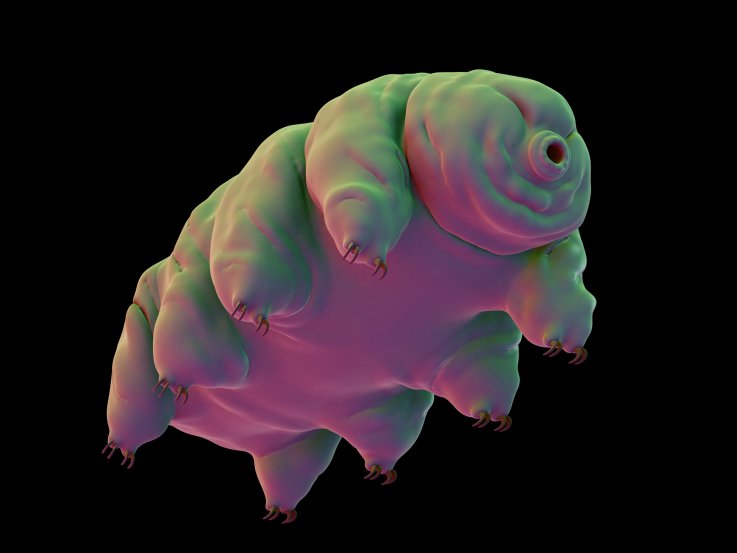Join us: facebook.com/unitedhumanists
Scientists worries by thousands of tardigrades crash-landing on the moon: ‘We have no idea what can happen’
The Beresheet lunar lander mission on April 11 was historic: Funded and deployed by Space IL, it was the first Israeli spacecraft to travel beyond Earth’s orbit and the first private landing on the Moon.

Unfortunately for SpaceIL, things didn’t go as planned: Seconds before Beresheet (Hebrew for “beginning”) was supposed to land, it lost contact with the control room. During the braking procedure, the main engine stopped operating. By the time it was brought back online, it was too late for a soft landing and Beresheet crashed onto the surface.
On board was a “lunar library” created by the Arch Mission Foundation as kind of time capsule for the combined knowledge of human civilization. The library contained samples of human DNA and 30 million pages of digital and analog data, including a full copy of Wikipedia, an Israeli flag, a Torah and a copy of the Israeli Declaration of Independence.
It also housed thousands of tardigrades—microscopic eight-legged animals also known as “water bears.”
The creatures were chosen for their unique biological qualities: Tardigrades have the ability to survive for incredibly long periods without food or water, entering a dormant phase where their metabolic functions come to a complete stop. In lab conditions, scientists have brought tardigrades back to life after ten years in this state. But it’s not clear how long they could last in the near-vacuum of Moon.
Arch Mission co-founder Nova Spivack told AFP he believed the chances that the tardigrades survived the crash “are extremely high.”
Having those creatures unmonitored on the Moon’s surface, even in suspended animation, has some scientists concerned.
NASA’s Office of Planetary Protection (OPP) has established guidelines for how sterile planetary missions need to be. “Uncontrolled biological contamination of the Moon’s surface is not scientifically ideal,” said OPP director Dr. Lisa Pratt in a statement after the crash.
Other scientists were more upset: Astrobiologist Monica Vidaurri posted a Twitter thread in which she detailed the potential ramifications of letting private organizations dump whatever they want on the Moon’s surface.
“Tardigrades on the Moon is not good,” wrote Vidaurri, who works as a science consultant at the NASA Goddard Space Flight Center. “It is not exciting. It is not cute. It is the result of a major gap in accountability for planetary protection and ethics between public and private science, and we have no idea what can happen as a result.”
Tardigrades on the moon is not good. It is not exciting. It is not cute. It is the result of a major gap in accountability for planetary protection and ethics between public and private science, and we have no idea what can happen as a result.
— Monica Vidaurri (@AstroTraviesa) August 10, 2019
Some dismissed her concerns as paranoia: “The Moon is a dead world with no atmosphere, crazy temperature swings, and high radiation,” tweeted one person on the thread. “Nothing can happen to dried out husks.”
Others came to Vidaurri’s defense.
“I think you’re entirely missing the point, which is about the absence of regulations or controls on how these kinds of actions are considered,” added Chris Britt, an outreach scientist for Hubble and James Webb Space Telescopes. “What if a private company sent a mission to Europa and contaminated it? There are no processes in place to stop it, is the point.”
With another Moon mission not planned until 2024, though, “It is unlikely that [the tardigrades] will be rescued in time,” physicist Rafael Alves Batista told AFP. “So my guess is that, even if they survived, they are doomed.”
Still, there are good arguments for not sending terrestrial life to other planets—chief among them avoiding “false positives” for biomarkers of life by future explorers.
Scientific American‘s Caleb Scharf believes that tardigrades were probably already on the Moon’s surface before the Beresheet incident. The tiny animals have existed on our planet for more than 530 million years—through five mass extinctions. Scharf argues meteor impact ejections from Earth may have wound up there at some point and left tardigrade fossil samples—or even hibernating tardigrades.
“Water bears” have become a popular subject of research, with studies isolating the genes that trigger their hibernation and implanting it into other organisms. The U.S. military is funding studies, for example, that use tardigrade DNA to preserve vaccines, human blood and organs.
Although NASA has criticized the failed mission, America’s space agency has done its part to contaminate the surface of the Moon, too: The Apollo astronauts left almost a hundred bags of feces there in the late 60s and early 70s.
Despite the setback, the Arch Mission Foundation isn’t giving up: It’s partnering with another private spaceflight company, Astrobotic, to send a copy of Wikipedia encoded as synthetic DNA to the Moon in 2021.
Source: http://bit.ly/31j3Qsn
